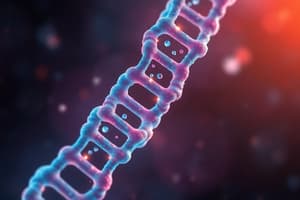Podcast
Questions and Answers
A chromosome that has gained extra genes has undergone a mutation called a(n):
A chromosome that has gained extra genes has undergone a mutation called a(n):
- addition (correct)
- linkage
- translocation
- point mutation
One of the consequences of nondisjunction is that:
One of the consequences of nondisjunction is that:
- the diploid number of chromosomes is formed.
- no gametes can be formed.
- the gametes do not receive equal numbers of chromosomes. (correct)
- the offspring are of homozygous genotypes and phenotypes.
How many pairs of chromosomes does a normal human body cell contain?
How many pairs of chromosomes does a normal human body cell contain?
- 36
- 46
- 18
- 23 (correct)
How many autosomes do humans gametes contain?
How many autosomes do humans gametes contain?
If genes in an allele pair are identical, the organism is:
If genes in an allele pair are identical, the organism is:
A karyotype is:
A karyotype is:
A nucleotide consists of:
A nucleotide consists of:
The condition in which a pair of homologous chromosomes does not separate during meiosis is called:
The condition in which a pair of homologous chromosomes does not separate during meiosis is called:
Which is of the following is not generally a source of genetic variation in a species?
Which is of the following is not generally a source of genetic variation in a species?
Flashcards
Addition Mutation
Addition Mutation
Mutation where a chromosome gains extra genes.
Consequence of Nondisjunction
Consequence of Nondisjunction
Gametes don't receive equal chromosome numbers.
Human Body Cell Chromosome Pairs
Human Body Cell Chromosome Pairs
23 pairs
Autosomes human gametes contain
Autosomes human gametes contain
Signup and view all the flashcards
Homozygous
Homozygous
Signup and view all the flashcards
Karyotype
Karyotype
Signup and view all the flashcards
Nucleotide Consists Of
Nucleotide Consists Of
Signup and view all the flashcards
Nondisjunction
Nondisjunction
Signup and view all the flashcards
NOT a source of genetic variation
NOT a source of genetic variation
Signup and view all the flashcards
Study Notes
- A chromosome that has gained extra genes has undergone an addition mutation
- One consequence of nondisjunction is gametes do not receive equal numbers of chromosomes
- A normal human body cell contains 23 pairs of chromosomes
- Human gametes contain 22 autosomes
- If genes in an allele pair are identical, the organism is homozygous
- A karyotype is a picture analysis of chromosomes
- A nucleotide consists of a phosphate, sugar, and a nitrogen base
- The condition in which a pair of homologous chromosomes does not separate during meiosis is called nondisjunction
- Mitosis cell division is not generally a source of genetic variation in a species
Studying That Suits You
Use AI to generate personalized quizzes and flashcards to suit your learning preferences.




